Forex trading can be exciting and fast-paced for traders who jump in without a plan. But it’s often not until you’ve hit rock bottom that you learn the true importance of technical analysis and charting. Technical analysis is the key to understanding the market, the ebbs and flows, and what might come next. Savvy traders use technical analysis to identify trends, chart patterns, key levels, and indicators. In this blog post, we’ll dive into technical analysis and how it can help you chart your success in the forex market.
1. A Basic Overview of Technical Analysis
Technical analysis is the study of price and volume on a chart. It’s the practice of analyzing past market data and patterns to predict future market movements. Technical analysts use charts and other tools to identify trends, key levels, and chart patterns. Some technical analysts also use mathematical indicators to help identify trading opportunities. Analysis typically starts with the daily chart, then moves on to the shorter timeframes, such as hourly or even minute charts.
2. Understanding Chart Patterns
Price charts are the foundation of technical analysis, and chart patterns are the building blocks. Chart patterns are essentially technical formations that can signal a potential price reversal or continuation. Some of the most popular chart patterns include head and shoulders, triangles, and double tops and bottoms. Each pattern can indicate where a potential trend is breaking or may start – providing valuable information for traders.
3. Key Levels, Resistance, and Support
Another important element of technical analysis is understanding key levels and support and resistance levels. Support is a level where buyers are more likely to come into the market and prevent prices from falling further. Resistance is a level where sellers are more likely to enter and push prices back lower. Key levels, on the other hand, are areas where price action is likely to react before continuing its trend, making them a valuable tool for identifying breakouts or reversals.
4. The Role of Indicators
Technical indicators can help traders identify potential trading opportunities and measure the strength of a trend. Oscillators measure the momentum of a price trend and provide important information about overbought and oversold levels. Some popular indicators include the Relative Strength Index (RSI), Stochastic Oscillator, and Moving Average Convergence Divergence (MACD).
5. The Importance of Risk Management
While technical analysis can be an effective tool for trading, it’s important to remember that no system is without risk. The Forex market can be unpredictable, and technical analysis is by no means foolproof. It’s important to remember that risk management should be a top priority when trading Forex. This means setting limits on your exposure, using stop-losses, and avoiding over-leveraging your trades.
Conclusion:
Technical analysis is an important tool for traders looking to chart success in the Forex market. By understanding chart patterns, key levels, and technical indicators, traders can identify potential opportunities to buy or sell. However, trading always comes with risk, and it’s important to practice risk management to protect yourself from potential losses. Technical analysis should be used alongside a solid trading plan and a disciplined approach to trading in order to achieve long-term success.


